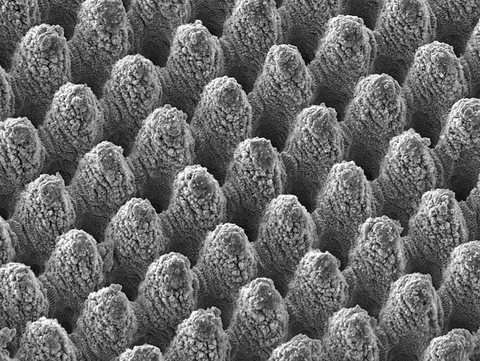
 ©LMO / TU德累斯顿
©LMO / TU德累斯顿激光加工的金属表面可自动清洁表面。各个结构元件之间的距离(“峰”到“峰”的距离)为10微米。相比之下,人的头发的直径为50-80微米。
研究项目“ LAMPAS”正在研究金银丝雕刻的生产速度,以将基于激光的工艺推向市场,从而创造了世界纪录。
在德累斯顿工业大学(德累斯顿工业大学),基于激光的表面功能化的欧洲旗舰研究项目“ LAMPAS”已经开始。作为Horizon 2020计划的一部分,该项目将在未来三年内由欧盟(EU)提供超过510万欧元的资金。目的是开发一种基于激光的工艺,该工艺可以在最短的时间内在不同的表面上产生大的金丝雕刻。众所周知,基于激光的表面功能化被认为是诸如医学技术,汽车工业或能源研究等应用领域的创新和有前途的研究领域。
研究项目协调人兼负责人Andrés-FabianLasagni教授说:“我们确信结果将在各个行业取得突破性进展,因此,我们能够赢得欧洲领先的研究项目合作伙伴感到非常高兴。” 德累斯顿工业大学基于大面积激光的表面结构设计的椅子,很高兴。
在接下来的三年中,研究团队打算开发一种基于激光干涉的工艺,该工艺可以经济高效地将大面积的微米和纳米结构应用于各种表面。挑战在于微结构比人的头发要小。为了开发广泛市场的工艺,德累斯顿的科学家们正在研究这种结构的生产速度的世界纪录。该项目正在开发一种新的激光束源,其输出功率为1.5千瓦,并产生超短激光脉冲。
研究人员受到自然界的启发。自清洁荷花效应(也称为蝴蝶翅膀)是基于微结构和纳米结构的表面。从这个意义上讲,表面改性技术真正替代了以前的复合材料或涂层表面,并提供了新的工业可能性(例如,抗菌表面,易于清洁的表面,抗指纹涂层)。
由德累斯顿大学年轻激光工程师,AndrésFabian Lasagni教授组成的国际团队是欧盟“ Horizon2020”研究竞赛中信息和通信技术类别的最佳参与者之一(ICT-04-2018,授权号:825132 )。在接下来的三年中,德累斯顿工业大学的科学家将与来自行业和研究机构的国际合作伙伴一起进行研究,包括博世,Trumpf,博世-西门子-豪斯格拉特(BSH),Next Scan Technology,近红外技术(NIT),Lasea和欧洲光子产业联盟(EPIC)。
媒体查询:
Dr.-Ing教授。安德烈斯·法比安·拉萨尼(AndrésFabiánLasagni
)机械科学与工程学院
大面积基于激光的表面结构
教研室电话:+49 351 463-33343
andres_fabian.lasagni@tu-dresden.de

该项目是光子学公私合作组织的一项举措。www.photonics21.org
(Grant Nr:825132)
本文档仅反映作者的观点,欧盟对其所含信息的任何使用概不负责。
 © LMO/TU Dresden
© LMO/TU DresdenLaser machined metal surface for self-cleaning surfaces. The distance between the individual structural elements (distance "peak" to "peak") is 10 micrometers. In comparison, a human hair has a diameter of 50-80 micrometers.
Research project "LAMPAS" is working on the world record for the production speed of filigree engravings in order to bring laser-based processes to market maturity.
At the Technische Universität Dresden (TU Dresden) the start has given for the European flagship research project "LAMPAS" on laser-based surface functionalization. The project is being funded by the European Union (EU) with more than 5.1 million euros over the next three years as part of the Horizon 2020 program. The aim is to develop a laser-based process that can produce large filigree engravings on different surfaces in the shortest possible time. It is commonly known that laser-based functionalization of surfaces is regarded as an innovative and promising field of research for applications such as medical technology, the automotive industry or energy research.
"We are sure that the results will be groundbreaking for various industries and are therefore very pleased that we were able to win the leading European partners for the research project," says Prof. Andrés-Fabian Lasagni, coordinator of the research project and holder of the chair of large area laser based surface structuring at the TU Dresden, pleased.
Over the next three years, the research team intends to develop a laser interference-based process that can cost-effectively apply large-area micro- and nanostructures to various surfaces. The challenge is that microstructures are smaller than human hair. In order to develop the process for the broad market, the Dresden scientists are working on the world record for the production speed of such structures. The project is developing a new laser beam source that has an output power of 1.5 kilowatts and generates ultra-short laser pulses.
The researchers were inspired by nature. The self-cleaning lotus effect, also known from butterfly wings, is based on a micro- and nanostructured surface. In this sense, technologies for modifying surfaces become a real alternative to previous composite materials or for coating surfaces and offer new industrial possibilities (e.g. antibacterial surfaces, easy-cleaning surfaces, anti-fingerprint coating).
The international team around the young laser engineer of the TU Dresden, Prof. Andrés Fabian Lasagni, was among the best participants in the EU research competition "Horizon2020" in the category information and communication technologies (ICT-04-2018, Grant Nr: 825132). Over the next three years, scientists at TU Dresden will conduct research together with international partners from industry and research, including Bosch, Trumpf, Bosch-Siemens-Hausgeräte (BSH), Next Scan Technology, Near Infrared Technologies (NIT), Lasea and the European Photonics Industry Consortium (EPIC).
Media Inquiries:
Prof. Dr.-Ing. Andrés Fabián Lasagni
Faculty of Mechanical Science and Engineering
Chair of Large Area Laser Based Surface Structuring
Tel.: +49 351 463-33343
andres_fabian.lasagni@tu-dresden.de

The project is an initiative of the Photonics Public Private Partnership. www.photonics21.org
(Grant Nr: 825132)
This document reflects only the author’s view and the EU is not responsible for any use that may be made of the information it contains.
扫一扫在手机上阅读本文章
